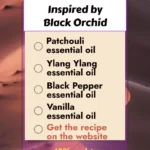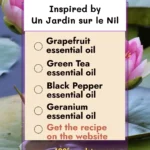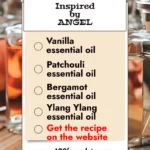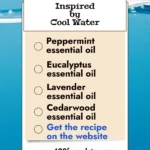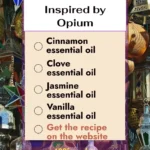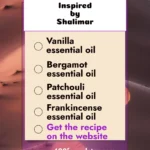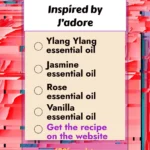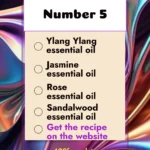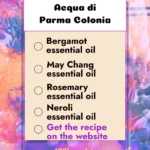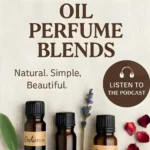Essential oils offer a natural way to create luxurious scents inspired by high-end perfumes. With just a few drops, you can craft your own signature fragrances at home. These DIY essential oil perfume blends allow you to enjoy designer-inspired perfume with essential oils, without the hefty price tag.
Table of Contents
*As an Amazon Associate, I earn from qualifying purchases
By mixing essential oils (EO’s), you can recreate many of the complex notes found in famous perfumes. This article provides 10 easy recipes that capture the essence of beloved fragrances. Each blend uses readily available EO’s to mimic the top, middle, and base notes of popular scents.
You’ll discover how to combine floral, citrus, woody, and spicy oils to achieve balanced and sophisticated aromas. These recipes are simple to follow and can be customised to suit your preferences. Get ready to explore a world of captivating scents right from your own home.
Essential Oils 101
Essential oils are concentrated plant extracts that capture the essence and aroma of their source. These potent substances offer a range of potential benefits when used properly.
Safety and Dilution Guidelines
Essential oils are powerful and require careful handling. Always dilute them in a carrier oil before applying to skin. A general rule is 20 drops of EO’s per 99g of carrier oil like jojoba or coconut oil.
Avoid using undiluted oils directly on your skin, as this can cause irritation or allergic reactions. Perform a patch test before widespread use of any new oil blend.
Some oils may increase sun sensitivity, so use caution when exposed to UV light. Pregnant women and those with certain health conditions should consult a doctor before using essential oils.
Store your oils in dark glass bottles away from heat and light. Keep them out of reach of children and pets. If accidental ingestion occurs, seek medical attention immediately.
When diffusing, use only 3 to 5 drops in water and limit sessions to 30 to 60 minutes. Open windows periodically to ensure proper ventilation in your space.
Perfumery Basics
Creating your own essential oil perfume blends involves understanding key principles and techniques. These skills allow you to craft unique scents that capture the essence of famous perfumes.
Understanding Fragrance Notes
Many perfumes with EO’s are composed of three layers of scents called notes. Top notes are the first impression, typically light and fresh like Green Mandarin, Sweet Orange, Lime, or Grapefruit. They evaporate quickly, lasting about 15 minutes.
Middle notes emerge as top notes fade, forming the heart of the scent, such as Jasmine, Marjoram, Spearmint, and Petitgrain. They last 2 to 4 hours and create the main character of the scent.
Base notes are the foundation, emerging last and lingering longest, such as Vetiver, Ylang Ylang, Cypress, Myrrh, and Sandalwood. They add depth and help fix other notes, often lasting 6 to 8 hours.
Understanding these layers helps you structure your blends effectively, creating a well-balanced and long-lasting perfume.
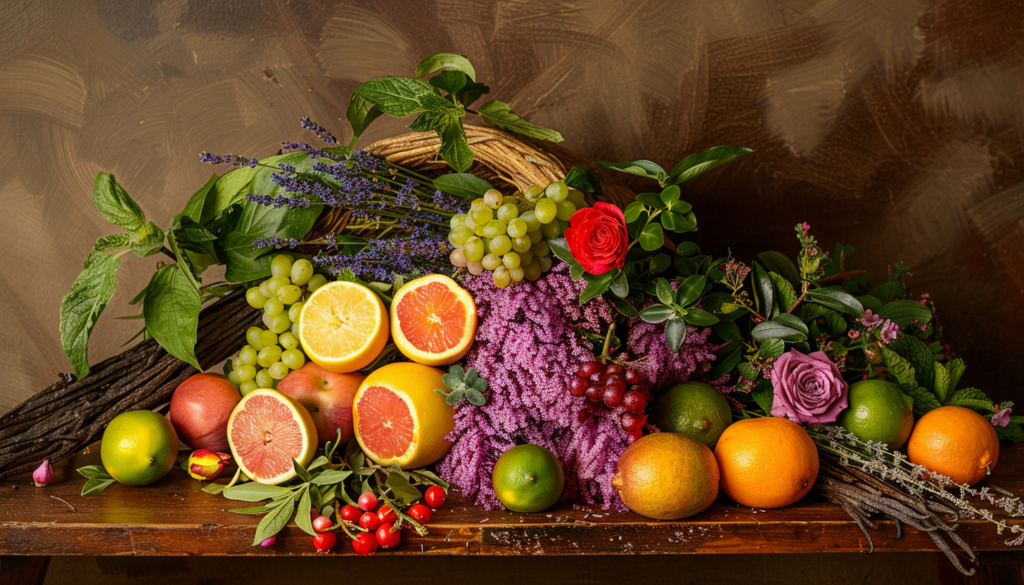
The Art of Blending
If you want to start designing your own essential oil perfume blends, start by making accords. A very simple way to do this is to use 5 shot glasses. Going from left to right, add 1 drop of Lavender in the first, 2 drops in the second glass, and so on to 5 drops in the 5th glass.
Then add 5 drops of Geranium in the first glass, 4 in the second, until you add 1 drop in the 5th glass.
Use a smelling strip to sample each one, and most likely one will jump out as more pleasant than the others. This is your first simple essential oil perfume accord.
To make the accord more complex, use the ratio of the accord you like, and with 5 clean glasses, add 1 drop of the accord to the first and so on until you add 5 drops to the 5th glass.
Then add 5 drops of Rosemary to the first glass and so on, until you add 1 drop to the 5th glass.
Using smelling strips, try each one, and the one you like the most will be a new accord.
This can be a lot of fun, and you will learn a lot about scent and what blends well. But if this sounds a bit too much, read on as I have put together very simple blends for you to make with no fuss.
Iconic Perfume Inspirations
Making perfumes is more complicated than I mentioned and usually requires at least 10 ingredients and dozens of other materials, just to get started! Many of these perfume ingredients will be synthetics because perfumes need these aroma molecules to give projection, depth, and complexity.
I have huge respect for indie perfumers, and I do not copy perfumes or make dupes. The perfumes mentioned here are an inspiration and are in no way copycat versions. I still hope that you enjoy them.
Creating Your Blends
The essential oil perfume blends are inspired by famous perfumes, providing a natural and customisable alternative for your own perfume. Each perfume recipe combines carefully selected oils to capture the spirit of its famous counterpart.
When you have found one you love, work out the ratio to fill small roller bottles. These are usually 10ml in size, but can vary. All the blends must be diluted before being used on the skin. To save you needing scales, these are very approximate safe levels.
20 drops of EO’s in total is approximately 1 ml or 1 gram. If the number of drops makes the math difficult, you can take this up to 25 drops. If you are using 10ml roller ball bottles, add the 20 (or up to 25) drops of essential oil perfume recipe and top up the bottle with jojoba oil or liquid coconut oil. Apply to your pulse points and wrists. Don’t forget to label the bottle and keep it away from children.
If you prefer to make a perfume spray, decide on the size of the bottle you are going to use. You can easily get slim 10 ml bottles, which are perfect for carrying in a bag or for travel. Add the 20 to 25 drops from whichever essential oil perfume recipe you like, then top it up to the shoulder of the bottle with ethanol alcohol such as Everclear. Vodka may not be strong enough to solubilise some of the heavier oils.
Stand the bottle in a small glass and wait for the oils to dissolve into the alcohol. You can put your thumb over the opening and shake the bottle. Heavier oils like Vetiver take longer to dissolve and it can be several hours! When everything looks well combined, add a few drops of distilled water and then put the spray top on.
Blend Number 1 – Angel
Inspired by Thierry Mugler Angel, this blend is sweet and gourmand. Use 3 drops of Vanilla, 2 drops of Patchouli, and 1 drop each of Bergamot and Ylang Ylang EO’s.
Vanilla and Patchouli form the core of this blend, mirroring the perfume’s signature contrast. Bergamot adds a hint of citrus freshness, while Ylang Ylang contributes a lush, floral note.
Mix the oils into 15 ml of fractionated coconut oil for a smooth, easily absorbed base. This is easily applied in a roller ball. You can also use any of the blends in a 100g amount of this FREE Body Butter Recipe.
Blend Number 2 – Cool Water
This blend channels the fresh, aquatic notes of Davidoff Cool Water. Combine 3 drops of Peppermint, 2 drops of Eucalyptus, and 1 drop each of Lavender and Cedarwood EO’s.
Peppermint and Eucalyptus create a crisp, invigorating top note reminiscent of ocean breezes. Lavender adds a subtle floral touch, while Cedarwood grounds the blend with its earthy aroma.
This blend is perfect for a refreshing body oil or room spray.
Blend Number 3 – Shalimar
Capturing the essence of Guerlain Shalimar, this blend is rich and oriental. Use 3 drops of Vanilla, 2 drops of Bergamot, and 1 drop each of Patchouli and Frankincense EO’s.
Vanilla forms the sweet, sensual core of this blend. Bergamot adds a citrusy brightness, while Patchouli and Frankincense contribute depth and mystique.
This combination works well as a perfume oil or in a diffuser for a warm, inviting ambiance.
Blend Number 4 – Acqua di Parma Colonia
This blend evokes the fresh, citrusy notes of Acqua di Parma Colonia. Mix 3 drops of Bergamot, 2 drops of May Chang, and 1 drop each of Rosemary and Neroli EO’s.
Bergamot and May Chang create a zesty, uplifting top note characteristic of the original cologne. Rosemary adds a herbaceous touch, whilst Neroli contributes a delicate floral undertone.
This blend is ideal for a refreshing body spray or linen mist.
Blend Number 5 – No.5
Inspired by Chanel No. 5, this blend exudes elegance and sophistication. Mix 3 drops of Ylang Ylang, 2 drops of Jasmine, and 1 drop each of Rose and Sandalwood EO’s.
The floral heart of Ylang Ylang and Jasmine mirrors the perfume’s iconic bouquet. Rose adds a touch of romance, whilst Sandalwood provides a warm, woody base note.
This blend has a long-lasting scent that suits a body butter very well.
Blend Number 6 – J’adore
This blend captures the essence of Dior J’adore. Combine 3 drops of Ylang Ylang, 2 drops of Jasmine, and 1 drop each of Rose and Vanilla EO’s.
Ylang-Ylang and Jasmine create a lush, floral heart reminiscent of the original perfume. Rose adds depth and romance, whilst vanilla provides a soft, sweet base note.
This combination is perfect for a luxurious body oil or bath oil.
Blend Number 7 – Black Orchid
Inspired by Tom Ford Black Orchid, this blend is dark and sensual. Use 3 drops of Patchouli, 2 drops of Ylang Ylang, and 1 drop each of Black Pepper and Vanilla EO’s.
Patchouli forms the earthy, mysterious base of this blend. Ylang-Ylang adds a rich floral note, whilst Black Pepper provides spicy warmth, and vanilla contributes a touch of sweetness.
This blend is ideal for a sultry perfume oil or sensual massage oil.
Blend Number 8 – Green Irish Tweed
This blend echoes the fresh, green notes of Creed Green Irish Tweed. Combine 3 drops of Lemon, 2 drops of Peppermint, and 1 drop each of Lavender and Cedarwood EO’s.
Lemon and Peppermint create a crisp, invigorating top note reminiscent of the cologne’s fresh opening. Lavender adds a subtle floral touch, while Cedarwood provides a woody base.
This combination works well as a refreshing aftershave or body spray.
Blend Number 9 – Opium
Capturing the essence of Yves Saint Laurent Opium, this blend is spicy and exotic. Use 3 drops of Cinnamon, 2 drops of Clove, and 1 drop each of Jasmine and Vanilla EO’s.
Cinnamon and Clove form the spicy heart of this blend, mirroring the perfume’s oriental character. Jasmine adds a touch of floral sweetness, whilst Vanilla rounds out the blend with warmth.
This blend is perfect for a warm, comforting room fragrance or personal perfume.
Blend Number 10 – Un Jardin sur le Nil
This blend evokes the fresh, herbal notes of Hermès Un Jardin sur le Nil. Blend 3 drops of Grapefruit, 2 drops of Green Tea, and 1 drop each of Black Pepper and Geranium EO’s.
Grapefruit provides a bright, citrusy top note, capturing the invigorating freshness of the original scent. Green Tea adds a complex, dry note, and Geranium brings a fruity, floral bouquet. The Black Pepper brings a spicy piquancy and earths the blend.
Conclusion
Creating your own essential oil perfume blends inspired by famous perfumes can be a rewarding experience. You can enjoy luxurious scents at a fraction of the cost of high-end fragrances. With practice, you’ll develop a keen nose for layering oils and crafting unique aromas.
Don’t be afraid to experiment and adjust the ratios to suit your preferences. Keep detailed notes on your blends to recreate your favourites. Remember to always dilute EO’s properly before applying to the skin.
These DIY blends make excellent gifts for friends and family. Consider packaging them in decorative roller bottles for an extra special touch. You might even discover a signature scent that becomes your new go-to fragrance. You can read more about how I use EO’s in these blog posts.
🎧 Listen Instead
Prefer listening? Play it here or catch it on your favourite platform:
FAQ
What is the best essential oil blend for beginners to start with?
Start simple. A classic beginner-friendly blend is lavender (middle), bergamot (top), and patchouli (base). It’s balanced, uplifting, and easy to tweak.
Do essential oil perfumes last as long as synthetic ones?
Not usually. Natural perfumes evaporate in layers- top notes fade fastest, base notes linger longer. Adding fixatives like benzoin or vetiver can help extend the scent.
Can I make perfume without alcohol?
Yes. You can use fractionated coconut oil or refined jojoba oil as a base for alcohol-free roll-ons or solid perfumes. They’re gentler on sensitive skin.
How do I layer top, middle, and base notes in a perfume?
Build from the base up. Blend base notes first (like sandalwood), then add middle notes (like rose), and finish with top notes (like orange). Let the blend sit before diluting.
What’s the difference between perfume, eau de toilette, and cologne?
It’s about strength. Perfume has 15% to 30% essential oil. Eau de toilette is lighter (4% to 8%). Cologne is lighter still (1% to 5%), better for quick refreshes.
How long should I let my essential oil perfume sit before using it?
Leave your blend to settle at least 5 to 7 days. This helps the oils merge and gives you a truer sense of the final scent once diluted.
Are essential oil perfumes safe for sensitive skin?
They can be, but always patch test first. Avoid known irritants like cinnamon, clove, or lemongrass. Dilute properly and stick to skin-safe oils.
Which oils act as natural fixatives in perfume?
Base notes like vetiver, benzoin, frankincense, myrrh, and patchouli help slow down evaporation and make your scent last longer.
Can I wear essential oil perfume in the sun?
Be careful. Oils like bergamot, lime, or lemon can cause photosensitivity. Choose sun-safe alternatives or avoid applying to exposed skin before sun exposure.
What tools do I need to start making essential oil perfumes?
You’ll need glass bottles, pipettes or droppers, a perfume diluent (like alcohol or carrier oil), blotting strips, and a notebook for your formulas.
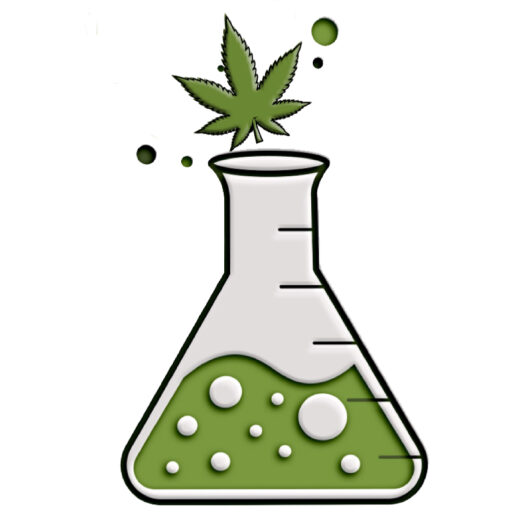
If you liked this blog post, I would love it if you shared it with a friend.
If you use Pinterest, please pin this post.


 Spotify
Spotify
